Understanding the language of iridología opens a fascinating window into holistic health assessment. This ancient practice of analyzing the iris to identify potential health concerns uses specific terminology that can seem complex at first. Whether you’re a health practitioner looking to expand your knowledge or simply curious about alternative health approaches, mastering these key terms will help you navigate the world of iridología with confidence.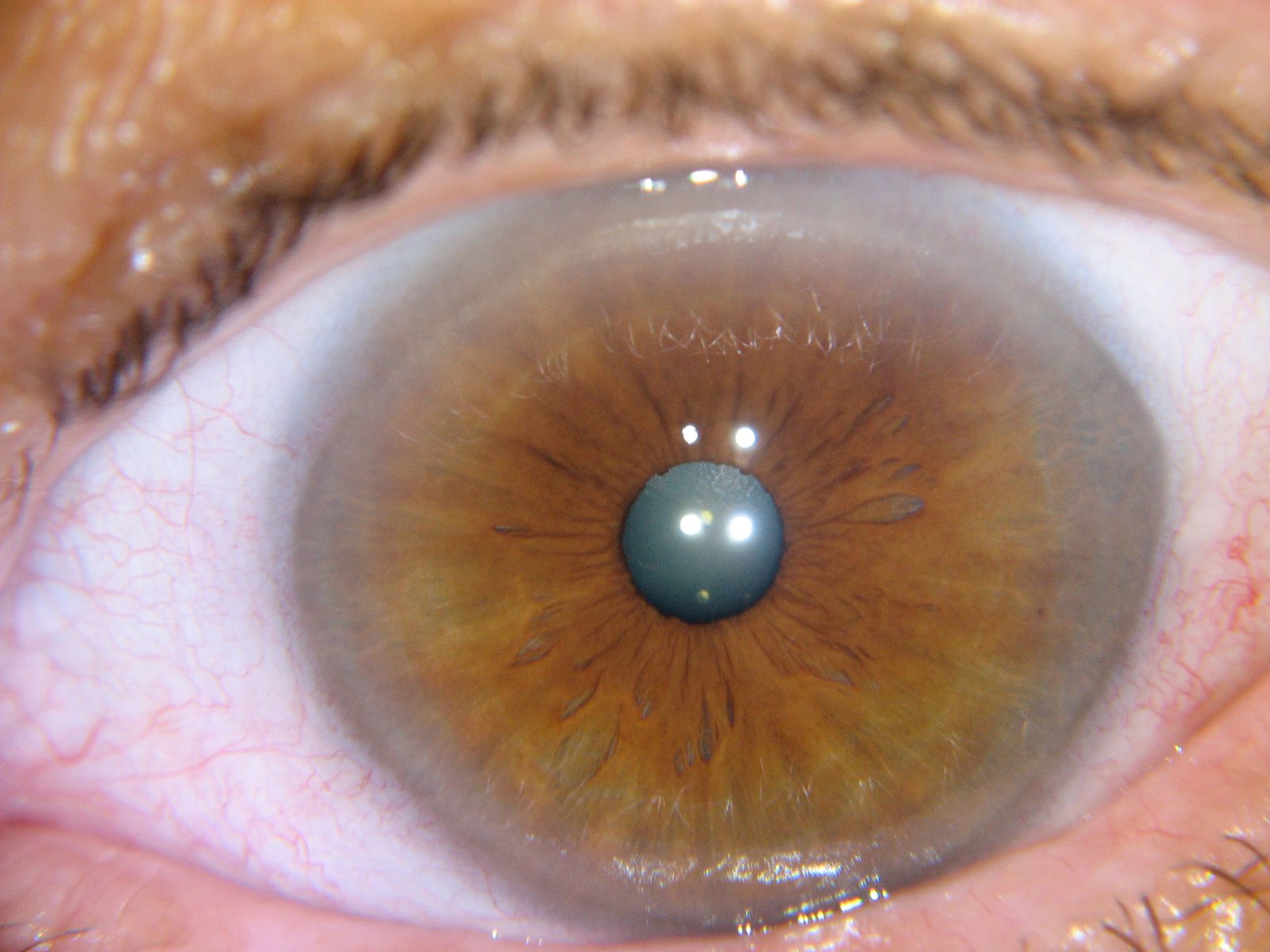



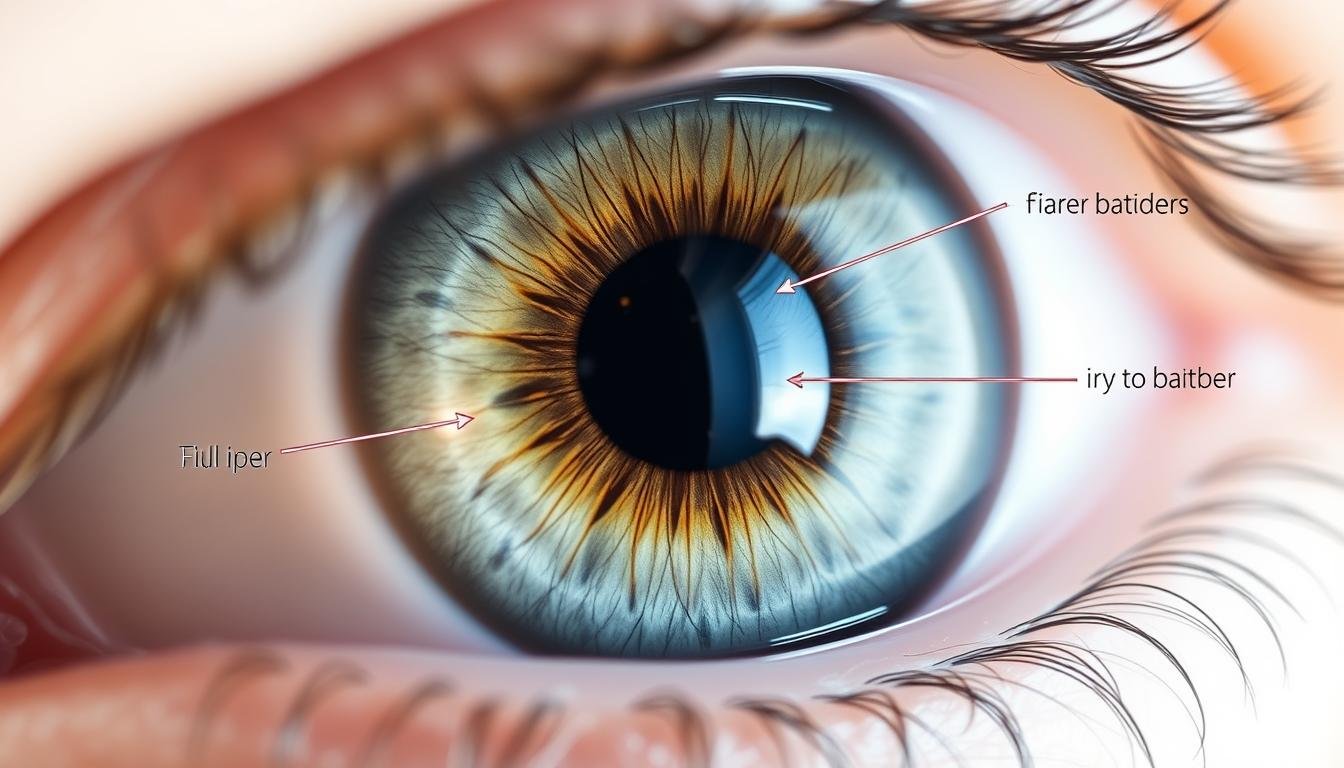
Qué es iridología? A Comprehensive Overview
iridología is the study of the iris (the colored part of the eye) to detect information about a person’s health status. Practitioners believe that each area of the iris corresponds to different organs and systems within the body, with changes in the iris’s appearance potentially indicating various health conditions or predispositions.
This practice is based on the concept that the iris contains a detailed record of the state of health of each organ and body system. iridología practitioners use specialized charts that map the iris into zones corresponding to different parts of the body, allowing them to identify potential health issues before they manifest as physical symptoms.

Begin Your iridología Journey
Discover how the ancient practice of iris analysis can reveal insights about your health and wellbeing.
Download Free Beginner’s Guide
La historia de iridología
las raíces de iridología trace back thousands of years, with evidence of iris examination appearing in ancient Egyptian, Chinese, and Greek texts. However, modern iridología tal como lo conocemos hoy comenzó a tomar forma en el siglo XIX.
Hungarian physician Dr. Ignatz von Peczely is often credited as the father of modern iridología. As a child, he noticed changes in an owl’s iris after the bird suffered a broken leg. This observation sparked his lifelong study of the connection between iris markings and physical health.
In the early 20th century, American chiropractor Dr. Bernard Jensen further developed iridología charts and techniques, bringing this practice to wider attention in Western alternative medicine circles. His detailed mapping of the iris created the foundation for many of the terms and concepts used by practitioners today.

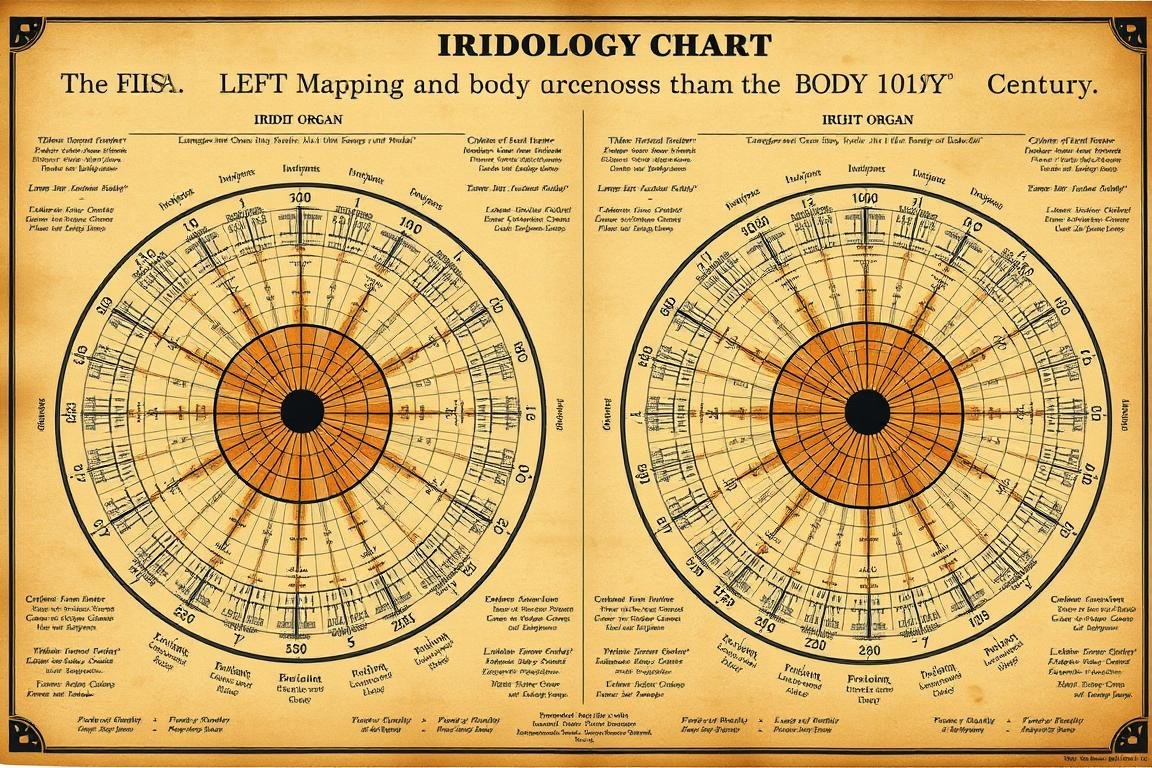
Essential iridología Terminology
To effectively understand and discuss iridología, you need to familiarize yourself with its specialized vocabulary. These terms describe the various structures, markings, and patterns observed in the iris during analysis.
Iris Structure Terms
- Collarette: The jagged boundary between the pupillary zone and ciliary zone of the iris, representing the autonomic nerve wreath.
- Zona pupilar: The inner area of the iris surrounding the pupil, associated with internal organs.
- Zona ciliar: The outer area of the iris extending to the sclera, associated with peripheral organs and systems.
- Criptas: Small, dark depressions in the iris that may indicate inherent weaknesses.
- Radio solar: Spoke-like lines radiating from the pupil, often associated with toxin elimination pathways.
Marcas de iris
- Lagunas: Enclosed dark areas in the iris that may indicate tissue damage or lesions.
- Psora: Small, distinct spots that may indicate toxin accumulation or inflammation.
- Manchas de pigmento: Colored deposits in the iris that may indicate mineral deposits or drug residues.
- Anillos nerviosos: Circular lines in the iris that may indicate nervous tension or stress.
- Rosario linfático: A series of white dots around the outer edge of the iris, potentially indicating lymphatic system congestion.
Analysis Terms
- Constitutional Type: The genetic iris pattern indicating inherent strengths and weaknesses.
- Acute Sign: Markings indicating active, current conditions.
- Chronic Sign: Markings indicating long-term or recurring conditions.
- Signos de curación: White lines crossing dark areas, suggesting healing processes.
- Borde: A dark ring at the outer edge of the iris, potentially indicating skin elimination issues.
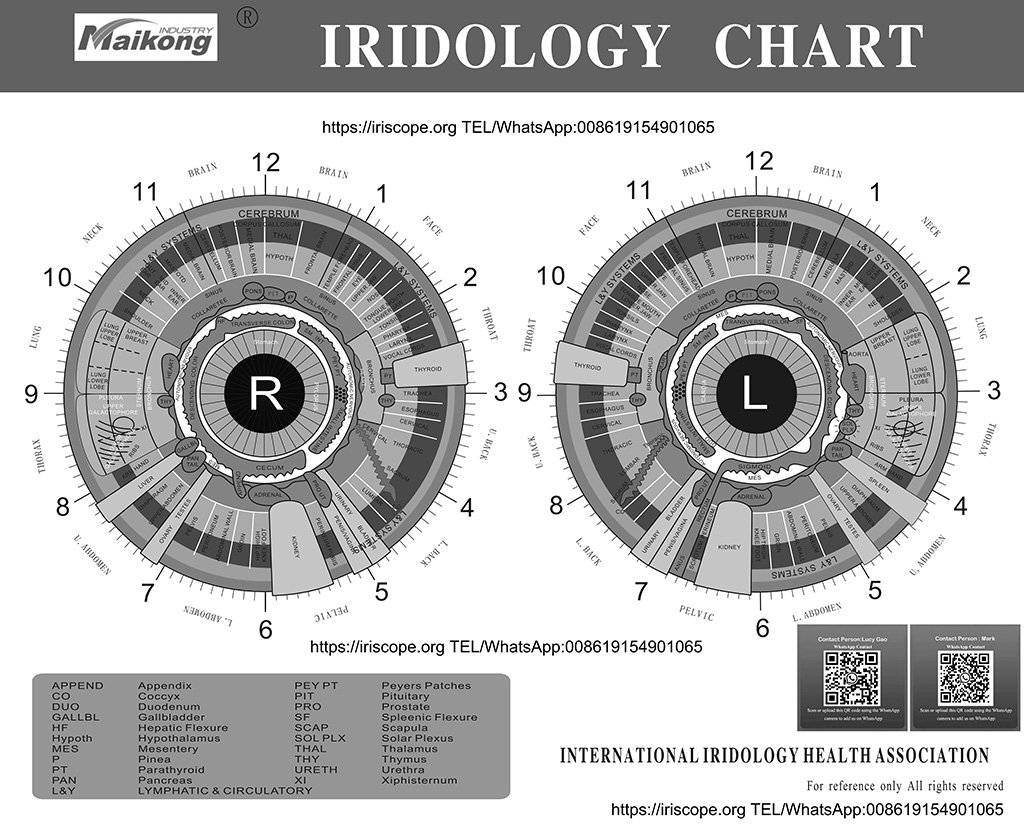
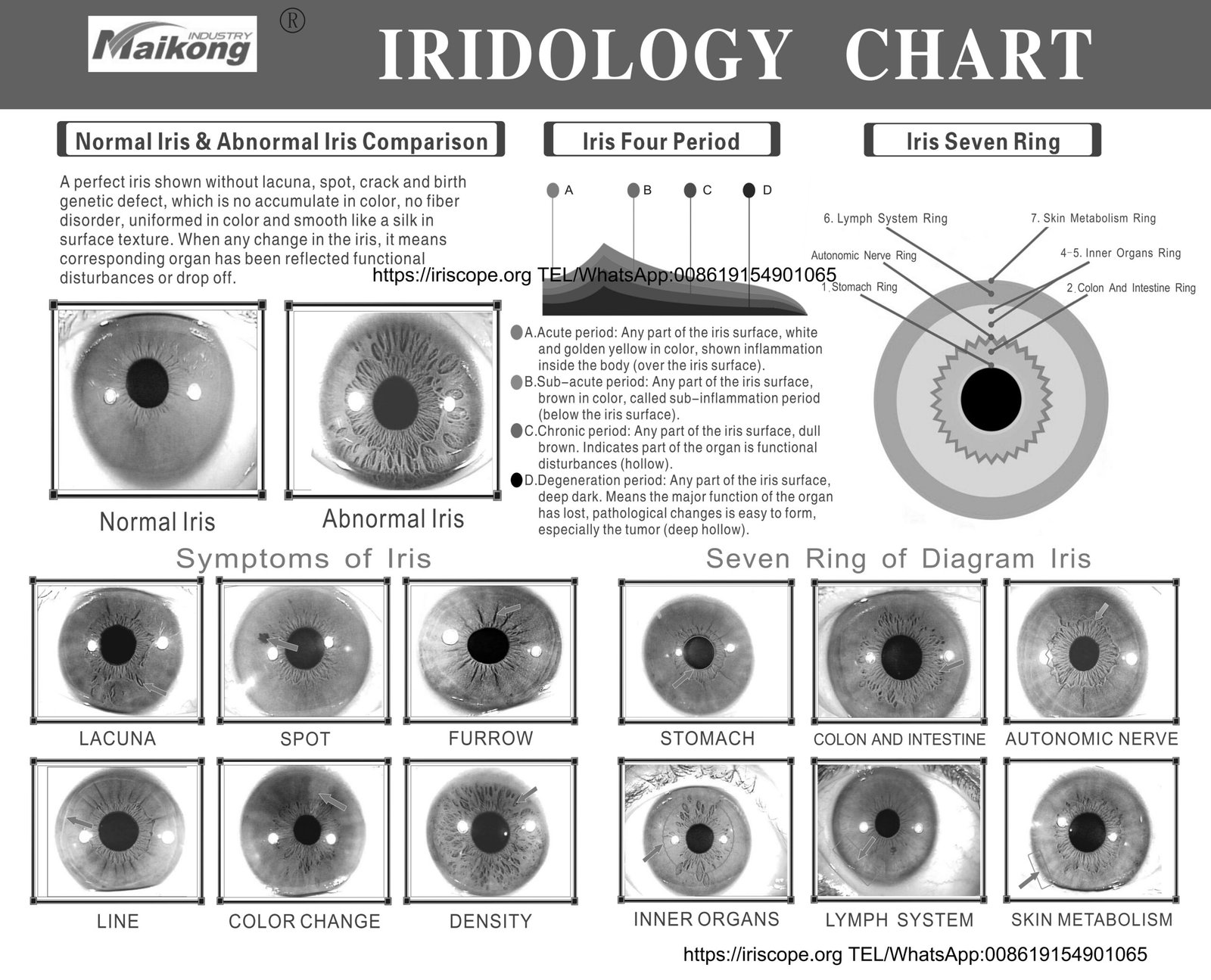

Iris Colors and Their Significance in iridología
En iridología, the base color of the iris provides fundamental information about a person’s constitutional type and inherent tendencies. Each color is associated with different metabolic characteristics and potential health predispositions.
| Iris Color |
Constitutional Type |
Characteristics |
Potential Strengths |
Potential Weaknesses |
| Blue |
Linfático |
Sensitive, responsive to environment |
Adaptable immune system |
Lymphatic congestion, respiratory sensitivity |
| Brown |
Hematogénico |
Strong metabolic activity |
Robust circulation, energy |
Liver, blood, and circulation issues |
| Mixed (Hazel) |
Biliar |
Combination of lymphatic and hematogenic |
Balanced systems |
Digestive sensitivity, liver stress |
| Green |
Mezclado |
Adaptable, balanced |
Good healing capacity |
Kidney and adrenal sensitivity |

Comprensión iridología Charts
iridología charts are essential tools that map the iris into zones corresponding to different organs and body systems. These detailed maps guide practitioners in interpreting the markings and patterns observed during iris analysis.
Most modern iridología charts divide the iris into approximately 80-90 zones, resembling a clock face. Each zone correlates to specific organs, glands, or body systems. The right iris generally corresponds to the right side of the body, while the left iris corresponds to the left side.

Key Zones on iridología Charts
- Brain and Nervous System: Usually mapped to the upper regions of the iris
- Sistema digestivo: Often located in the lower portions of the iris
- Sistema circulatorio: Typically found in the medial (nasal) portions
- Sistema linfático: Generally mapped to the lateral (temporal) portions
- Endocrine Glands: Often represented in specific points throughout the iris
- Sistema respiratorio: Usually located in the upper regions
- Sistema urinario: Often mapped to specific lower zones
- Sistema reproductivo: Typically found in the lower portions
- Sistema musculoesquelético: Generally represented in the outer zones
- Piel: Often mapped to the outermost edge of the iris
Master iridología Chart Reading
Download our comprehensive iridology chart with detailed zone explanations to enhance your practice or studies.
Get Your Free Chart
iridología Diagnostic Methods
Practicantes de iridología use various techniques and tools to examine the iris and interpret their findings. Understanding these methods is crucial for anyone interested in this field.
Examination Equipment
Basic Tools
- Penlight: For basic illumination of the iris
- Magnifying Glass: For closer examination of iris details
- Gráficos de iridología: Reference maps for interpretation
Advanced Equipment
- Iriscopio: Specialized microscope for iris examination
- Cámara digital con iris: For capturing high-resolution iris images
- Iris Analysis Software: For digital mapping and analysis
Documentation Methods
- Iris Photography: For creating a visual record
- Mapeo de iris: Documenting findings on charts
- Seguimiento de progreso: Comparing changes over time

iridología vs. Traditional Diagnostic Methods
| Aspecto |
iridología |
Traditional Medical Diagnostics |
| Acercarse |
Holistic assessment of overall health patterns |
Targeted investigation of specific symptoms |
| Invasividad |
Sólo observación no invasiva |
May involve invasive tests (blood draws, biopsies) |
| Enfocar |
Identifying constitutional tendencies and potential weaknesses |
Diagnosing existing conditions |
| Timeframe |
May detect potential issues before symptoms appear |
Typically addresses existing symptoms |
| Validación científica |
Limited scientific studies, primarily empirical evidence |
Extensive scientific research and clinical trials |
Benefits of Studying iridología
Learning iridología can provide numerous advantages for both health practitioners and individuals interested in holistic health approaches. Understanding these benefits helps explain why this practice continues to attract interest despite limited mainstream medical acceptance.
Advantages of Iridology Knowledge
- Provides a non-invasive method to assess health patterns
- Offers insights into constitutional strengths and weaknesses
- May help identify potential health issues before symptoms develop
- Complements other holistic health practices
- Encourages preventative health approaches
- Considera la interconexión de los sistemas corporales.
- Can be integrated with nutritional and lifestyle counseling
Limitaciones a considerar
- Limited scientific validation in mainstream medicine
- No debe sustituir el diagnóstico médico convencional.
- Requires significant study to interpret accurately
- Results can vary between practitioners
- May not detect acute conditions requiring immediate attention
- Best used as a complementary approach, not a standalone diagnostic tool

Enhance Your Holistic Practice with iridología
Join our comprehensive certification program and learn how to integrate iridology into your holistic health practice.
Explorar opciones de certificación
Aplicaciones prácticas de iridología
iridología has found applications in various holistic health contexts. Understanding how practitioners apply this knowledge helps illustrate its practical value in complementary health approaches.
Guía nutricional
Iridologists often use iris analysis to identify potential nutritional needs and deficiencies. By recognizing patterns associated with specific organ systems, practitioners can suggest targeted dietary adjustments to support those areas.

Salud preventiva
By identifying constitutional weaknesses before they manifest as symptoms, iridology can guide preventative health strategies. This early-warning approach allows for lifestyle modifications that may help prevent the development of chronic conditions.

Evaluación complementaria
Many holistic practitioners use iridology alongside other assessment methods to create a more comprehensive health picture. This integrated approach combines iris analysis with other techniques such as pulse diagnosis, tongue analysis, or functional testing.

Common Questions About iridología
As you explore the field of iridología, you may have questions about its practice, effectiveness, and applications. Here are answers to some frequently asked questions.
Es iridología científicamente probado?
iridología has limited scientific validation in mainstream medicine. While some studies have explored correlations between iris markings and health conditions, the practice is primarily supported by empirical evidence and case studies from practitioners. It’s best viewed as a complementary approach rather than a replacement for conventional medical diagnosis.
How long does it take to learn iridología?
Basic understanding of iridología principles can be gained in a few months of dedicated study. However, becoming proficient typically requires 1-2 years of study and supervised practice. Most professional certification programs include both theoretical knowledge and practical application, with courses ranging from 6 months to 2 years depending on depth and intensity.
Poder iridología diagnose specific diseases?
iridología is not designed to diagnose specific diseases. Rather, it identifies constitutional strengths and weaknesses, potential areas of concern, and overall health patterns. Practitioners use iris analysis to suggest which body systems may need support, but specific medical diagnoses should always come from qualified healthcare professionals using conventional diagnostic methods.
¿Los patrones del iris cambian con el tiempo?
The basic structure and constitutional patterns of the iris remain relatively stable throughout life. However, certain markings, coloration, and tissue density can change in response to health conditions, healing processes, and aging. These changes are what iridologists observe to track health patterns over time, though the fundamental iris structure remains consistent.
How does iridología relate to other holistic practices?
iridología often complements other holistic health practices such as naturopathy, herbalism, nutritional therapy, and traditional Chinese medicine. Many practitioners integrate iris analysis with these approaches to create comprehensive health assessments and personalized wellness plans. The insights from iridología can help guide the application of these other modalities for more targeted support.

Embracing the Language of iridología
Mastering iridología terminology opens doors to a fascinating approach to holistic health assessment. By understanding the vocabulary, charts, and methods used in this practice, you gain valuable insights into how practitioners view the connection between iris patterns and overall health.
Whether you’re considering studying iridología professionally or simply expanding your knowledge of complementary health approaches, this terminology guide provides a solid foundation. Remember that while iridología offers unique perspectives on health patterns, it works best as part of an integrated approach to wellbeing that includes conventional healthcare when needed.
Continue exploring this fascinating field, and you’ll discover how the ancient wisdom of iris analysis continues to evolve alongside our modern understanding of health and wellness.
Take Your iridología Knowledge Further
Join our community of iridology enthusiasts and practitioners to continue learning and sharing insights.
Join Our Iridology Community
































